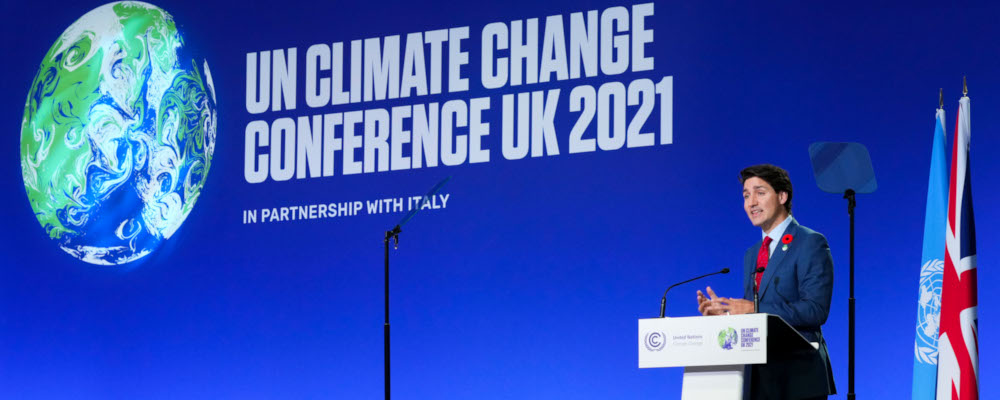The COP26 climate change conference in Glasgow, Scotland, has thus far been marked by inclement rhetoric about the exigencies of climate change. One can discern a growing tendency on the part of some political leaders and climate activists towards alarmism, despair, and an overarching message of degrowth.
The U.S. climate czar John Kerry, for instance, recently described the meetings as “the last best chance the world has to come together in order to do the things we need to do to avoid the worst consequences of the climate crisis.” Young climate activist Greta Thunberg has similarly characterized the gravity of the climate challenge as “dark and hopeless” and called for “fundamental changes to our society.”
Not only are these messages bound to fail in terms of animating and inspiring citizens as Macdonald-Laurier Institute senior fellow Ken Coates rightly notes, but they also fail to recognize that “climate change is fundamentally a technology problem” as American innovation scholar Eli Dourado has put it.
Substantial and durable carbon emissions reductions will not come from a Thunbergian rejection of capitalism’s capacity for invention and innovation. It will only ultimately come from leveraging the dynamism and ingenuity inherent in the Schumpeterian process of Creative Destruction. The goal of net-zero emissions, in short, must be a pursuit of progress rather than the succumbence to stagnation.
It’s worth stating it as clearly as possible: there’s no constituency—except perhaps for a minority of fringe voices—prepared to accept lower living standards in exchange for significant climate action. That trade-off is a non-starter in Canada and elsewhere around the world.
If degrowth is a path to inevitable political instability and ultimate backtracking on the environment, then we must choose a different one.
Our climate goals must instead be rooted in developing and scaling breakthrough technologies in energy, industrial production, building construction, transportation, and so forth. So-called “eco-modernists” like Michael Shellenberger and Alex Trembath are the true proselytizers of climate progress. We need a frontier agenda for climate-related innovation and technology.
When U.S. President John F. Kennedy famously committed to reaching the moon by the end of the 1960s in a September 1962 speech at Rice University, he acknowledged that some of the necessary materials and technologies hadn’t yet been invented. His audacious goal was, in this sense, “an act of faith and vision.”
The same goes for today’s goal of achieving net-zero emissions by 2050. Uncertain scientific and technological breakthroughs will necessarily be a key determinant as to whether we hit that target.
Research by the Canadian Institute for Climate Choices, for instance, estimates that “safe bet” technologies such as electric vehicles, energy-efficiency equipment, and electric heat pumps and baseboard heaters can contribute at least one third of the emissions reductions required to meet Canada’s 2050 target. The rest of the progress will need to come from “wild card” technologies that are currently undeveloped or may not yet even exist.
The goal of net-zero emissions, in short, must be a pursuit of progress rather than the succumbence to stagnation.
Faith and vision are therefore necessary but insufficient conditions to catalyse these much-needed breakthrough technologies. We also need an ambitious policy agenda to bring faithful expression to such a vision.
This will necessarily involve a combination of scientific pursuits, major capital investments, and broad-based technology adoption. There will doubtless be a role for public policy to support in each of these areas—including expanding support for scientific research, using public investments to reduce investor risks, and providing incentives to encourage the domestic adoption of new, emission-reducing technologies.
The basic goal of this panoply of public-private arrangements must be to catalyse a pipeline of new ideas and technologies and then help them transition from the laboratory to the market for the purposes of commercialization and broad adoption in the name of ultimately achieving a zero-carbon economy.
But as important as individual government programs and policies may be, they’re no substitute for a clarity of purpose and vision. A major foundation of a frontier agenda will require a similar culture of endeavour and progress that Kennedy envisioned in his historic “moonshot” speech.
If one accepts that climate change is fundamentally a technology problem—that new technologies are our only realistic means of significantly netting out carbon emissions—then public policy must be oriented towards greater development and progress.
Take one example: Canadian climate policy experts have argued in favour of major energy infrastructure projects to connect provinces with “abundant clean hydroelectricity with parts that are currently more dependent on fossil fuels for electricity generation.” This might involve, for instance, connecting British Columbia’s emissions-free electricity to Alberta where more than 80 percent of the province’s electricity comes from fossil fuels. The projected return-on-investment in terms of emissions reductions would be significant.
The problem, of course, is that in the current context of never-ending Indigenous consultations, environmental assessments, and regulatory permitting, virtually no one thinks that these types of major, emissions-reducing projects are credible in the short term, or possibly even ever. It’s important to recognize that the obstacle here isn’t a technological one. Instead it reflects the cumulative consequences of our own political and policy choices.
We’ve so wrapped ourselves up in a labyrinth of bureaucratic red tape that we’re unable to pursue public or private investments that could make meaningful contributions to our climate goals. One of the perverse outcomes is that it will invariably force governments and companies to accept far more costly yet still more achievable emission abatement options.
The key, then, is that, as Dourado argued in a recent testimony to a U.S. congressional committee on net-zero emissions, “We must make it easier to build.” We must come to see climate change as a problem of scarcity rather than abundance.
Policymakers must in turn make it far easier to build public infrastructure, invest in private capital (including industrial plants or new forms of energy or lithium mining projects), or carry out research and development that can contribute to the goal of decarbonization. We must, in other words, reject decadence and paralysis in favour of development and progress.
Which brings us back to the ongoing COP26 conference. Bill Gates, who first attended the 2010 Paris climate talks, has since said that he was struck by how they never talked about innovation. Early signs suggest that this hasn’t changed enough more than a decade later.
For the roughly 20,000 attendees, there’s still a preference for what Gates has called the “easy” over the “hard” among most international policymakers, and a self-righteous vision of climate action among activists that view welfare losses as a sign of earnest commitment.
They’re both wrong. The race to net-zero emissions will only be won through innovation, technology, and progress. And that will in turn require a combination of faith, vision, and a plan.
Recommended for You

The Notebook by Theo Argitis: Mark Carney’s first major tests

‘Those deficits are almost surely going to rise’: Trevor Tombe on the fiscal challenges facing the Carney government

‘There can be massive policy investments made in AI literacy’: Five takeaways from John Stackhouse, Janice Gross Stein, and Jaxson Khan on the race for AI adoption in Canada

Brace for impact: something big is about to happen to the news in Canada




